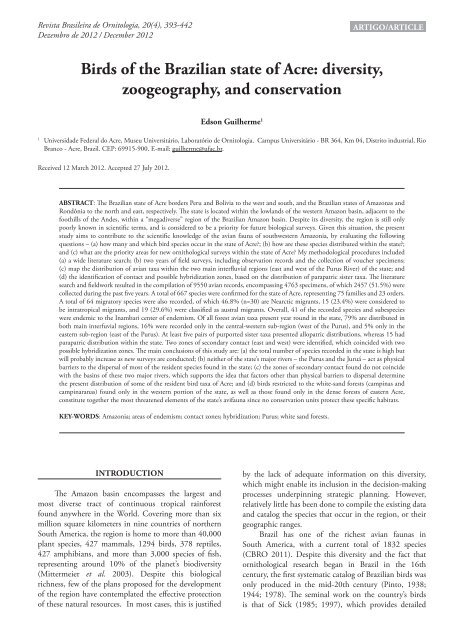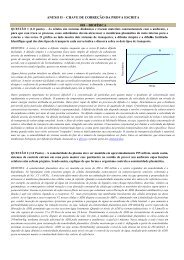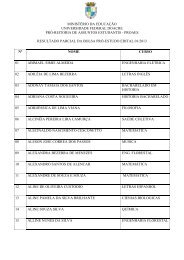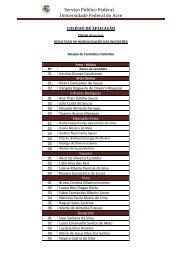Revista Brasileira de Ornitologia - Universidade Federal do Acre
Revista Brasileira de Ornitologia - Universidade Federal do Acre
Revista Brasileira de Ornitologia - Universidade Federal do Acre
You also want an ePaper? Increase the reach of your titles
YUMPU automatically turns print PDFs into web optimized ePapers that Google loves.
<strong>Revista</strong> <strong>Brasileira</strong> <strong>de</strong> <strong>Ornitologia</strong>, 20(4), 393-442Dezembro <strong>de</strong> 2012 / December 2012artigo/ARTICLEBirds of the Brazilian state of <strong>Acre</strong>: diversity,zoogeography, and conservationEdson Guilherme 11Universida<strong>de</strong> Fe<strong>de</strong>ral <strong>do</strong> <strong>Acre</strong>, Museu Universitário, Laboratório <strong>de</strong> <strong>Ornitologia</strong>. Campus Universitário - BR 364, Km 04, Distrito industrial, RioBranco - <strong>Acre</strong>, Brazil. CEP: 69915-900. E-mail: guilherme@ufac.br.Received 12 March 2012. Accepted 27 July 2012.ABSTRACT: The Brazilian state of <strong>Acre</strong> bor<strong>de</strong>rs Peru and Bolivia to the west and south, and the Brazilian states of Amazonas andRondônia to the north and east, respectively. The state is located within the lowlands of the western Amazon basin, adjacent to thefoothills of the An<strong>de</strong>s, within a “megadiverse” region of the Brazilian Amazon basin. Despite its diversity, the region is still onlypoorly known in scientific terms, and is consi<strong>de</strong>red to be a priority for future biological surveys. Given this situation, the presentstudy aims to contribute to the scientific knowledge of the avian fauna of southwestern Amazonia, by evaluating the followingquestions – (a) how many and which bird species occur in the state of <strong>Acre</strong>?; (b) how are these species distributed within the state?;and (c) what are the priority areas for new ornithological surveys within the state of <strong>Acre</strong>? My metho<strong>do</strong>logical procedures inclu<strong>de</strong>d(a) a wi<strong>de</strong> literature search; (b) two years of field surveys, including observation records and the collection of voucher specimens;(c) map the distribution of avian taxa within the two main interfluvial regions (east and west of the Purus River) of the state; and(d) the i<strong>de</strong>ntification of contact and possible hybridization zones, based on the distribution of parapatric sister taxa. The literaturesearch and fieldwork resulted in the compilation of 9550 avian records, encompassing 4763 specimens, of which 2457 (51.5%) werecollected during the past five years. A total of 667 species were confirmed for the state of <strong>Acre</strong>, representing 75 families and 23 or<strong>de</strong>rs.A total of 64 migratory species were also recor<strong>de</strong>d, of which 46.8% (n=30) are Nearctic migrants, 15 (23.4%) were consi<strong>de</strong>red tobe intratropical migrants, and 19 (29.6%) were classified as austral migrants. Overall, 41 of the recor<strong>de</strong>d species and subespecieswere en<strong>de</strong>mic to the Inambari center of en<strong>de</strong>mism. Of all forest avian taxa present year round in the state, 79% are distributed inboth main interfuvial regions, 16% were recor<strong>de</strong>d only in the central-western sub-region (west of the Purus), and 5% only in theeastern sub-region (east of the Purus). At least five pairs of purported sister taxa presented allopatric distributions, whereas 15 hadparapatric distribution within the state. Two zones of secondary contact (east and west) were i<strong>de</strong>ntified, which coinci<strong>de</strong>d with twopossible hybridization zones. The main conclusions of this study are: (a) the total number of species recor<strong>de</strong>d in the state is high butwill probably increase as new surveys are conducted; (b) neither of the state’s major rivers – the Purus and the Juruá – act as physicalbarriers to the dispersal of most of the resi<strong>de</strong>nt species found in the state; (c) the zones of secondary contact found <strong>do</strong> not coinci<strong>de</strong>with the basins of these two major rivers, which supports the i<strong>de</strong>a that factors other than physical barriers to dispersal <strong>de</strong>terminethe present distribution of some of the resi<strong>de</strong>nt bird taxa of <strong>Acre</strong>; and (d) birds restricted to the white-sand forests (campinas andcampinaranas) found only in the western portion of the state, as well as those found only in the <strong>de</strong>nse forests of eastern <strong>Acre</strong>,constitute together the most threatened elements of the state’s avifauna since no conservation units protect these specific habitats.KEY-WORDS: Amazonia; areas of en<strong>de</strong>mism; contact zones; hybridization; Purus; white sand forests.INTRODUCTIONThe Amazon basin encompasses the largest andmost diverse tract of continuous tropical rainforestfound anywhere in the World. Covering more than sixmillion square kilometers in nine countries of northernSouth America, the region is home to more than 40,000plant species, 427 mammals, 1294 birds, 378 reptiles,427 amphibians, and more than 3,000 species of fish,representing around 10% of the planet’s biodiversity(Mittermeier et al. 2003). Despite this biologicalrichness, few of the plans proposed for the <strong>de</strong>velopmentof the region have contemplated the effective protectionof these natural resources. In most cases, this is justifiedby the lack of a<strong>de</strong>quate information on this diversity,which might enable its inclusion in the <strong>de</strong>cision-makingprocesses un<strong>de</strong>rpinning strategic planning. However,relatively little has been <strong>do</strong>ne to compile the existing dataand catalog the species that occur in the region, or theirgeographic ranges.Brazil has one of the richest avian faunas inSouth America, with a current total of 1832 species(CBRO 2011). Despite this diversity and the fact thatornithological research began in Brazil in the 16thcentury, the first systematic catalog of Brazilian birds wasonly produced in the mid-20th century (Pinto, 1938;1944; 1978). The seminal work on the country’s birdsis that of Sick (1985; 1997), which provi<strong>de</strong>s <strong>de</strong>tailed










